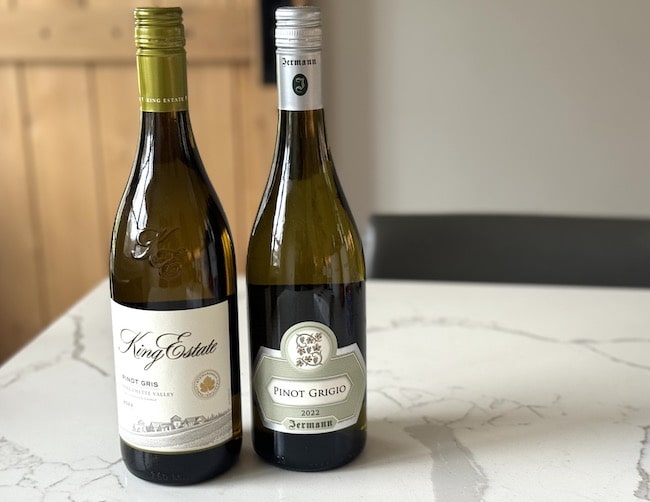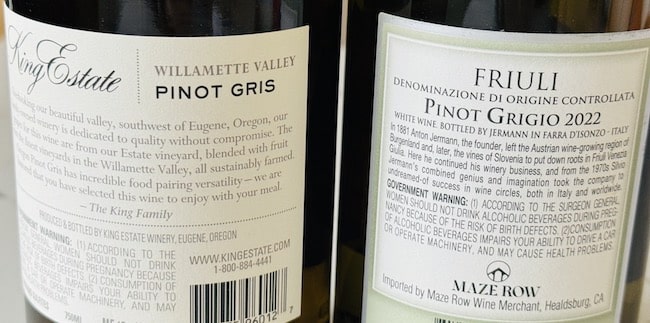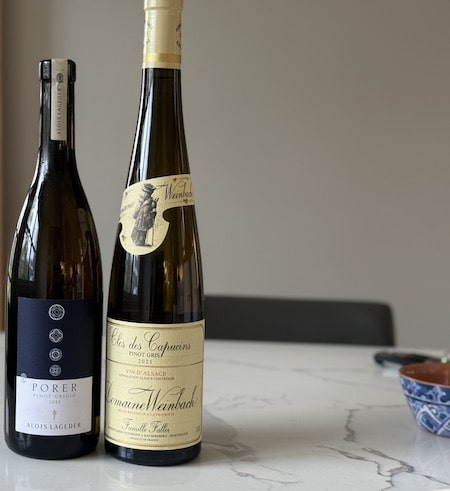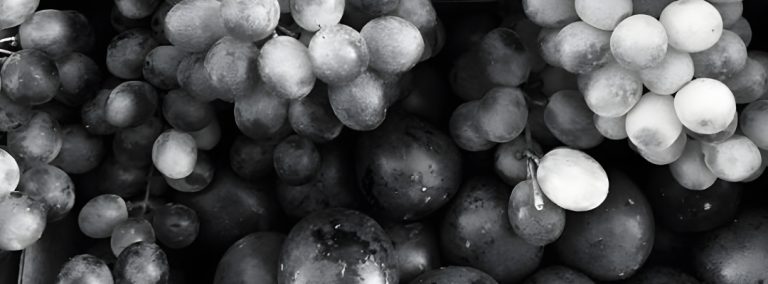Pinot Gris and Pinot Grigio are two popular white wines you’re likely to see on most bar and restaurant wine lists. But did you know they are actually made from the same grape? The difference in names comes from the skin of the grape. It’s a pinkish gray color and called Pinot Gris in France, where gris is the French word for gray, and Pinot Grigio in Italy where grigio is the Italian word for gray. In the United States and New Zealand, they use both names.
Which name a winery chooses may be influenced by different factors. In commercial production, Pinot Grigio is favored because it’s more universally recognized and the wine will likely sell better. On the other hand, Pinot Gris tends to be used for more handcrafted wines from smaller producers, although there are always exceptions.
And while Pinot Grigio and Pinot Gris come from the same grape, these wines can have distinct differences in flavor and body depending on the winemaker and the style they are aiming for, as well as where the grapes were grown.
Italian Pinot Grigio mainly comes from the Veneto, Friuli, Alto Adige and Trentino regions. French Pinot Gris is produced in Alsace. In New Zealand, Pinot Gris / Pinot Grigio can come from several growing regions, and in the United States you’ll find this wine is primarily from Oregon, Washington State and California. Note, wines from Oregon tend to be called Pinot Gris.
Pinot Grigio is an excellent wine for summer as it’s light, fresh and has good acidity, with a crisp finish. You’ll be able to taste plenty of fruit like citrus, apple and pear, and Pinot Grigio / Pinot Gris can go well with different foods. It’s typically a dry table wine, but you may find some bottles of Alsatian Pinot Gris are made in an off-dry or dessert wine style.
Good quality Pinot Gris / Pinot Grigio will run between $15-25. You can pay $35+ for higher-end single-vineyard wines, and if you see wine priced in the $7-10 range, it usually means it’s commercially produced Pinot Grigio. It will make a perfectly fine drinking wine, but may lack distinction.

Different styles depending on where the wine comes from
Pinot Grigios / Pinot Gris can be made in different styles depending on the country and regions where they come from. You’ll find differences in color, taste, oak aging, when the grapes were harvested, how much residual sugar the wine contains (how dry it is), and/or factors related to terroir and climate.
Pinot Grigio from Italy
Italian Pinot Grigio is crisp and has good acidity with citrus flavors, including lemon and grapefruit, as well as notes of apple. It’s a wine that’s mostly made in a dry style and you can expect it to be light to medium-bodied.
A lot of Italy’s Pinot Grigio is actually for export and in America the wine has garnered a reputation as being fairly average, a simple and easy-drinking white. Nonetheless, some Pinot Grigios from Italian regions in the north are more likely to be handcrafted, single-vineyard wines, aged in neutral oak. They can be lean and mineral driven, or more rich in texture, with stone fruit. You can learn more about the regional differences further down in this article.
Pinot Gris from Alsace, France
Alsace is a region made up of small producers vs the big commercial wine brands you find in Italy. Located in the northeast of France, the Pinot Gris vineyards straddle the foothills of the Vosges Mountains. Pinot Gris from France tend to be more medium to full-bodied with a rich texture and mouthfeel. You can still taste the citrus, but you’ll find more stone fruit notes like peach and sometimes honey, ginger and herbs in the flavor profile. Alsatian Pinot Gris can also be spicy, creamy and have nutty or smoky notes. The wine is typically aged in oak.
In Alsace, as in Germany, grapes are sometimes harvested later in the year. The longer the grapes stay on the vine, the more sugars will be in the wine which results in an off-dry or even sweet dessert level wine. Dessert level Pinot Gris from France is called Vendange Tardive as well as Sélections de Grains Nobles.

Pinot Gris from Oregon
Pinot Gris produced in the Pacific Northwest tends to be made in a dry to medium-dry style. The wine is usually fruit vs mineral driven and can be aged in neutral oak, which gives it a bit more body. This Pinot Gris has a slightly rich texture, though not to the extent of French Pinot Gris. You’ll taste hints of lemon but a difference in style compared to Italian wine, with softer notes of pear and yellow apple.
More about the grape varietal
The Pinot Grigio / Pinot Gris grape is in the same family as Pinot Bianco (bianco means white in Italian) and Pinot Noir (noir means black in French). In fact, Pinot Gris is actually a mutation of the Pinot Noir grape. The skin of the grape tends to be darker than most white wine varietals and it’s considered a productive vine that’s early ripening and easy to grow. There can be differences in acidity levels depending on the altitude of the vineyards and when the grapes are harvested. More distinctive Pinot Grigios and Gris tend to come from hillside vineyards where soils are leaner and the vines have had to struggle more.
Wine Trivia: When a winemaker leaves the Pinot Grigio grape on its skins for a short amount of time, the wine can pick up more body and some pinkish color. This style of wine is called Ramato and is the old, traditional way of making Pinot Grigio.

Regions in Italy where they grow the Pinot Grigio grape
- Trentino. Trentino is an area in the northeast where a lot of large scale Pinot Grigio production comes from. They tend to make more simple and straightforward white wines in the medium to low price range.
- Alto Adige. This is a mountainous region with smaller wineries that produce quite distinctive wines. Pinot Grigios from this area are known to be lean and mineral driven vs rich. Look for good acidity and a touch of salinity. You’ll taste lemon, peach, pear and grapefruit, hints of almond, and floral notes in the wines. Expect to pay $20+ a bottle.
- Friuli. They also grow Pinot Grigio grapes in the Friuli region of Italy which has some coastline and sits just above Venice and the Veneto. The wines here are richer in texture and can have stone fruit flavors like pear and golden apple, in addition to lemon and hints of almond. The highest quality Pinot Grigio comes from two sub districts in the hills, Collio and Collio Orientale. This wine runs at $25+ a bottle. There’s also Friuli Grave which is a flatter region with larger wineries. It’s known to have highly aromatic wines which are excellent expressions of the grape.
- Delle Venezia DOC. Delle Venezia is a Pinot Grigio designation that was introduced in 2016. It covers grapes that come from the Trentino, Friuli and Veneto regions and tells you they were grown in some of the better districts for Pinot Grigio. It also guarantees the wine was produced according to a set of specific guidelines. Expect good quality wine in the mid-price range.
Pinot Grigio goes great with food
It’s no surprise that Pinot Grigio tops the list of white wines by the glass in most Italian restaurants. The citrus flavors, along with the high acidity make it a perfect wine for pairing with different dishes. You might have Pinot Grigio with your entree, think a Caprese salad, and then move to a red wine that’s Sangiovese-based. Alternatively, stick with Pinot Grigio for the night and order a pasta cooked in lemon and white wine sauce. This wine goes perfectly with shellfish and is an ideal pairing for linguine alle vongole (linguini with clams) or seafood risottos (you can pair it with sushi too if you’re having Japanese food). Note, Pinot Gris from Alsace goes particularly well with Asian dishes as it can stand up to some spice. Because it’s such a versatile wine, Pinot Grigio is a favorite for passed appetizers as well, where different flavors are on show.

5 Food pairing tips for Pinot Gris and Pinot Grigio
- An aged Pinot Gris from Alsace is a natural with cheese. The difference with older white wines is they tend to pick up more texture and nutty hints. Alsatian Pinot Gris can be aged for 10-15 years depending on the style. While many people think of red wines for cheese boards, try an aged Pinot Gris at your next wine and cheese gathering and you won’t be disappointed.
- Charcuterie boards and Pinot Grigio from Friuli are a perfect match. Wines from this area of Italy often have great texture to them and can hold their own against the spices you get in cured meats. The acidity in the wine will also help to break down some of the fats. If you’re looking for a glass of wine to go with a melon and prosciutto appetizer, look no further.
- Oysters go best with Pinot Grigio from Alto Adige. If you’re having oysters, Pinot Grigio makes a great wine food pairing, particularly a bottle from Alto Adige where the wines are crisp, have good minerality and high acidity.
- For a barbecue, pick up a bottle of Oregon Pinot Gris. Barbecue food is often marinated and can have a range of sweet and spicy flavors. The rich tones in this Pinot Gris will go particularly well with grilled chicken, vegetables and pork, though you may want a red wine if you’re grilling steaks.
- Serve a California Pinot Grigio with appetizers before a meal. This is a perfect neutral white wine to serve with a variety of light foods. A lot of the Pinot Grigio you find from California (vs Oregon) is lighter in body, but the wine will still be fresh, crisp and dry.





